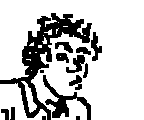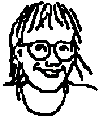 Short
Autobiography of Robert John Jenkins Junior
Short
Autobiography of Robert John Jenkins Junior
- Family background
- Where he was
- The big projects
- Organized Activities
Bob Jenkins was born in Akron, Ohio in 1966 to Barb and Bob
Jenkins. He is at least 1/4 Welsh, 1/4 German, 1/8 English,
and 1/16 Irish.
Very few relatives are on the web anymore.
 Bob now lives in Redmond, Washington, with his son.
His wife Justine is a short slight blonde person (see the sketch on
the right). She grew up in Salinas California.
Bob now lives in Redmond, Washington, with his son.
His wife Justine is a short slight blonde person (see the sketch on
the right). She grew up in Salinas California.
Bob grew up in Akron. A rough history of where he's been:
- He attended King School for grades K-6 and Litchfield and Firestone
for grades 7-12. He did phenomenally well in grade school, excelling in
math, art, and music.
- He did very well in high school (Litchfield Junior High and Firestone
High), studying math, physics, chemistry, computers, and German.
- At Carnegie Mellon ('85-'89), he dropped out of Electrical Engineering
to major in Math and Computer Science. He did pretty well. He got a
bachelor's in Math/CS and a masters in CS (thesis was on knots) in 4 years. He was a nature director at Camp Winnebago in
the summers of '86 and '87, and developed software for IBM in Owego NY
in '88. He was in CMU's Math Studies program, which emphasized
proving things instead of memorizing formulaes.
- '89-'92 was spent in Foster City, California, working for Oracle. He
started ballroom dancing and met his future wife (Justine Ehlers).
- A year at UC Berkeley in the doctoral program for theoretical computer
science convinced Bob that he didn't want to become a professor.
- After leaving Berkeley in '93 he returned to Oracle. Justine married
him in '94 (on a beach in Monterey), and they bought a townhouse in Foster City.
- Bob and Justine had a girl in '98, a boy in '00, and another girl
in '02. That's it says Justine, three's enough, no more after that.
- They moved to Redmond, Washington in 2006, and Bob went to work for
Microsoft.
Bob is always working on some project in his spare time.
- In grade school, it was learning piano and composing music. He won a
national contest for a piano piece he wrote in 3rd grade.
- In high school, religion and philosophy was the subject.
In the end Bob concluded that he didn't believe in God after all, and
philosophy was depressing. He tries to avoid these subjects now.
- College (Carnegie
Mellon) saw guitar playing, mathematics,
NP-completeness, and the weekly comic strips
Overload (printed in
the Tartan,
the newspaper that printed what people wanted to hear) and
Spare Change (printed in the
Student Union, the newspaper that printed what people wanted to say).
Overload featured a student named Mike, his roommate Paul, the
setting of Carnegie Mellon, and no plot or character development.
Spare Change, also sometimes titled short change, loose change,
loose shorts, or whatever the editor thought he remembered at the
moment, tended to be one-panel things.
- Perpetual motion machines
were the project for the three years between Carnegie Mellon and
Berkeley, when Bob first worked for Oracle. He did Oracle numbers,
snapshots, and from-clause subqueries at that time. He got into the
stock market and barely broke even for a number of years. He also dabbled with science fiction and
children's stories.
- Berkeley was an endurance test. He lived in the damp basement of an
ivy covered building on the corner of College and Dwight. Once he slept
through a jackhammer that was a foot away from his head (the arrangement
of the bed, the window, and the sidewalk outside made this feasible).
Sometimes he did 16 hour days (12 awake, 4 sleep).
- After Berkeley convinced Bob that he did not want to become a
professor, the project became pseudorandom
numbers. It started with a cryptography course from Manuel Blum
at Berkeley. Bob bought a 66mhz 486 in July '93 and started writing
random number generators and tests for them. ISAAC took shape around April '94 and
was published (Bob's first
publication!) in February '96.
- In February '95, the Hash Join project at Oracle made Bob realize that
all the tools for random numbers worked equally well on hashing, and that existing hashes were
pretty bad. His second publication was an article on hashing in Dr. Dobb's
in March '97. In 2007 he entered a cryptographic hash in the
government SHA-3 competition, but researchers quickly broke it.
- In December '95, he discovered that CompuServe provides space for
a web page. His life seems to be a hunt
for entertaining ideas and solutions to problems, which are both
useless without some way to publish them, so the web is a truly
wonderful thing.
- Fall of '97 Bob took a Java class, and December of '97 he built a
color choosing widget in Java.
Summer of '98 he built a solar system
simulator, and in early '99 he found good formulas for numerical integration of
the n-body problem.
- Tiling the plane with pentagons is in
the background; it is a problem he knows how to solve with flashy (but
useless) solutions. Compare that to hash lookup, which is terribly
useful but very tedious to explain. It appears other people have
completely solved the problem of pentagons which tile the plane
anyways. In late '98 and early '99 Bob painted some of these tilings
on his bathroom walls.
- Genealogy was a big thing at
age 10, briefly reemerged at age 16, then came back again in force in
2001 with the discovery of genealogy software. He wanted to find all
his third cousins and tell them who their third cousins were. In 2006
he started putting genealogy pages on
the web, in 2007 he had a go at making a genealogical wiki, and in
2010 he filled out his corner of the world on
Ancestry.
Organized activities often played a large role.
- The American Aquatics Union taught Bob to swim like a fish.
- Piano lessons were fun, and gave Bob familiarity with chord progressions.
- Little League did not produce a great baseball player, but Bob did
acquire a knack for spotting four-leaf clovers.
-
St. Paul's Men & Boy's Choir, first as a treble and later as an alto
and bass, included many Madrigal Dinners and trips to England and Italy.
Bob thinks that singing in a choir is an excellent team sport.
- Various church youth groups were part of the teenage experience.
- Boy Scouts tried to make a leader out of Bob, without much success.
Nevertheless, as a diligent student he made Eagle, and he quite enjoyed
being a nature director for a
Boy
Scout camp in college. Boy scouts and youth groups had lots of skits.
- A Phi O, a co-ed service fraternity at CMU, provided people to hang out
with. Again, Bob did not seem interested in this leadership thing.
- He hasn't belonged to much of anything since CMU.
Table of Contents
 Short
Autobiography of Robert John Jenkins Junior
Short
Autobiography of Robert John Jenkins Junior Bob now lives in Redmond, Washington, with his son.
His wife Justine is a short slight blonde person (see the sketch on
the right). She grew up in Salinas California.
Bob now lives in Redmond, Washington, with his son.
His wife Justine is a short slight blonde person (see the sketch on
the right). She grew up in Salinas California.